Zelda and Dungeons & Dragons: Dice and Storytelling

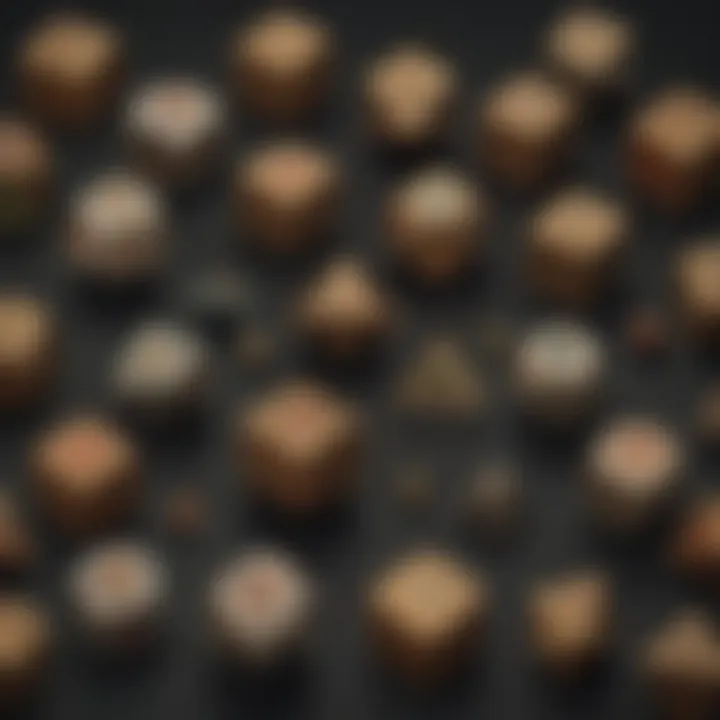
Intro
The interplay between the rich lore of the Zelda universe and the immersive experience of Dungeons & Dragons creates a tapestry that appeals to gamers and storytellers alike. The magical blend of familiar characters, intricate plots, and engaging mechanics from both realms offers limitless opportunities for creativity. At the heart of this convergence are the unique, themed dice that players utilize in D&D sessions inspired by Zelda's enchanting world.
This article delves into how these dice not only serve as tools for gameplay but also enhance the storytelling experience, strengthen community bonds, and amplify the cultural resonance of the Zelda franchise within tabletop gaming. By dissecting the significance of these beautifully crafted dice, we will explore their role in gameplay mechanics, their impact on narrative development, and how they help in weaving a seamless connection between two beloved universes. Let's embark on this journey of discovery, where every roll holds a story and every character embodies an adventure.
Game Reviews
Gameplay Features and Mechanics
When it comes to tabletop games, the mechanics function as the backbone. In Dungeons & Dragons, dice are pivotal. The inclusion of Zelda-themed dice introduces a layer of thematic depth that enriches the gameplay. These dice often reflect familiar symbols, colors, or characters from the Zelda series, like the iconic Triforce or potions. Rolling a die embossed with Link's spirit inspires players to think beyond standard gameplay; it adds an air of epic fantasy to each turn.
Moreover, unique dice customizing their own D&D experience shows a heightened level of engagement, ensuring that players feel directly connected to the legendary lore. Gamers who incorporate Zelda-inspired elements often find themselves crafting stories that echo the narratives of Hyrule, encouraging collaborative storytelling where everyone can contribute to epic quests reminiscent of those seen in their favorite games.
Storyline and Quests
A successful D&D campaign is built on captivating storylines and meaningful quests, elements that Zelda fans inherently appreciate. The ability to weave Zelda lore into a D&D session not only enhances the richness of the narrative but also provides a familiar framework for players. Campaigns can revolve around beloved locations like Hyrule Castle or the Lost Woods, inviting players to engage in quests that echo Link's adventures, such as rescuing Princess Zelda or reclaiming the Master Sword.
Players can create their own narratives yet still pay homage to the established lore, which often leads to creative reinterpretations. Perhaps a group of players set out to uncover the mysteries of the Ancient Temples, diving deeper into the lore while devising quests inspired by the puzzles found in Zelda games.
Visuals and Sound Design
While visuals aren’t the primary focus in D&D, how players visualize their dice and the world they explore can significantly alter their gaming experience. Zelda-themed dice might display swirling patterns and colors that evoke the mystique of the series. When players roll a die decorated with the familiar emblem of the Triforce, it not just serves gameplay but also fuels their imagination.
Accompanying soundscapes—whether they’re snippets from the Zelda soundtracks or ambient noises from the Hyrulian fields—also transport players into a world where every roll of the dice can lead to fantastical outcomes. The overlap of visual and auditory design becomes instrumental in crafting an immersive tabletop experience.
Comparison with Previous Titles
Intertwining Zelda lore with D&D mechanics isn’t just an innovation; it reflects a generational shift in how we experience gameplay. Previous iterations of D&D leaned heavily on traditional fantasy archetypes without the nuanced depth found in games like Breath of the Wild or The Legend of Zelda: Ocarina of Time. Modernized, thematic dice that acknowledge this evolution allow for more personalized experiences, appealing particularly to fans who’ve grown up with both franchises.
By comparing earlier D&D modules with contemporary stories that extract elements from Zelda, one can observe how gaming has progressed toward a more inclusive and narrative-driven format.
Culmination
The creative fusion of Zelda lore and Dungeons & Dragons through themed dice taps into a profound appreciation for storytelling and world-building. As players navigate the intersection of these two beloved universes, they not only enhance the D&D experience but also cultivate community ties rooted in shared passions and nostalgia. This exploration prompts deep conversations about what it means to blend different narrative threads and ultimately enriches the tapestry of tabletop gaming.
The Intersection of Zelda and Dungeons & Dragons
The blending of the Zelda universe and Dungeons & Dragons has become a topic of interest for enthusiasts across both realms. At first glance, these two universes may seem distinct, yet they harmoniously complement each other, offering a fertile ground for imagination and creativity. The intricate lore of Zelda, filled with legendary heroes, magical artifacts, and whimsical worlds, aligns seamlessly with the rich narrative possibilities inherent in D&D.
Engaging in this intersection elevates RPG sessions, enriching character development and the overall experience. Players can immerse themselves deeper when they see familiar elements from Zelda manifest in their campaigns, such as encountering a Dueling Robot or discovering a Temple akin to the famed Dodongo's Cavern. This not only sparks nostalgia but also encourages a diverse approach to storytelling.
The benefits of fusing these two gaming powerhouses include:
- Enhanced World-Building: By incorporating Zelda-inspired settings, D&D campaigns gain a unique flavor, inviting players into the lands of Hyrule while implementing familiar mechanics.
- Creative Gameplay: The hybridization encourages players to think outside the box. Implementing Zelda’s magical elements, like Triforce's wisdom, can influence decision-making in ways typical fantasy settings may not allow.
- Community Engagement: This blend fosters a sense of belonging among fans of both series, creating a vibrant community where experiences and ideas can be exchanged freely.
By exploring these connections, it becomes evident how substantial this fusion can be, not just for players but for the overall culture surrounding tabletop gaming.
Understanding the Appeal of Crossovers
Crossover events often make waves in the gaming community, especially when they tie into beloved franchises like Zelda and Dungeons & Dragons. There’s an innate thrill in seeing two giant institutions come together, appealing to fans who cherish both universes. The allure lies in combining iconic elements, ultimately offering players rich, layered narratives filled with enchantment and depth.
Players are drawn to the idea of integrating beloved characters and mythos from Zelda into their D&D campaigns. Just envision wielding Link's Master Sword in a climactic battle against a formidable foe or strategizing around the mischievous antics of Tingle. This blending of the worlds allows for the rejuvenation of gameplay experiences, where cherished aspects of nostalgia are married to the mechanics of D&D.
Additionally, many players relish the challenge. They might find it stimulating to adapt the heroic quests of Zelda into the more expansive, rule-heavy framework of D&D. This often leads to unforeseen twists and turns in the narrative. As they navigate challenges in a familiar yet foreign landscape, players grow emotionally invested, establishing connections that goes beyond mere mechanics.
Historical Context of Zelda in Tabletop Gaming
Zelda’s role in tabletop gaming is not entirely new. Over the years, various board games and adventures have emerged, aiming to capture the essence of this iconic franchise. Notably, games like The Legend of Zelda: The Adventure of Link in tabletop adaptations have contributed notable chapters to this narrative.
When Dungeons & Dragons hit the homes of eager gamers in the 1970s and beyond, the idea of merging it with widely recognized franchises was a matter of time. As Zelda debuted in the 1980s, the gaming landscape began to shift. The intricate storytelling and expansive worlds of Zelda started weaving their way into D&D campaigns, whether through modules crafted by fans or players adapting elements into their games.
The historical context also reveals the evolution of player engagement. No longer are people limited to merely rolling dice; they participate in acting out various roles, creating an emotional connection to the epic tales told within both series. The history underscores that as these franchises grew, so too did the potential partners in their respective fan bases, blurring the boundaries as it encouraged creativity across all levels of engagement.
"Merging beloved worlds invites players to rekindle their connections to iconic characters while sparking their own creativity in new narratives."
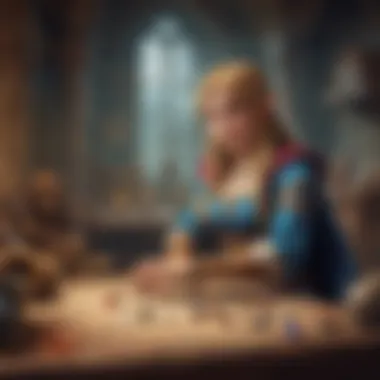
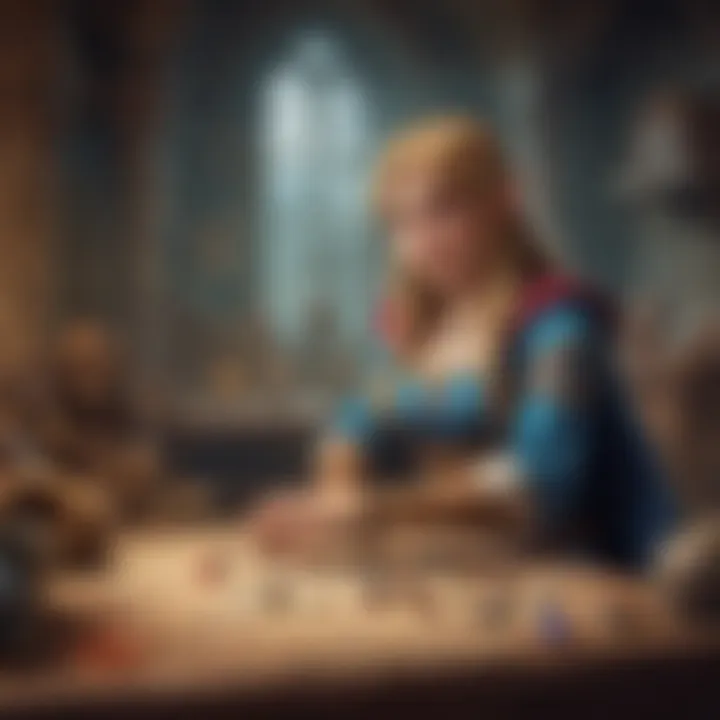
This cross-pollination continues to have profound implications, influencing how players approach storytelling within role-playing games. The importance of considering Zelda as a component in D&D settings showcases how tabletop gaming can innovate and push boundaries.
The Significance of Dice in Role-Playing Games
Dice have been the backbone of table-top role-playing games for decades. They serve not just as tools of randomness, but as integral components that bridge player intent with the unpredictable nature of the fantasy worlds they inhabit. Within the context of Zelda lore and Dungeons & Dragons, dice acquire layers of meaning, becoming symbolic artifacts that influence how stories unfold.
The significance of dice in role-playing games revolves around several core elements:
- Randomness and Uncertainty: Dice introduce a gamble element into gameplay. When a player rolls a die, they face uncertainty and anticipation, emulating the unpredictability of adventures in the Zelda universe. Every toss could open a door to new opportunities or peril.
- Decision-Making Mechanics: These chance devices require players to make decisions grounded in the potential outcomes. Should one take a risk with a high-stakes roll? Or play it safe with a strategy that limits chance? This tug-of-war between risk and reward is central to the D&D experience.
- Character Development: Rolling dice doesn’t just affect the game — it also ties directly into character progression. Each dice result helps define characters’ fates, morphing their narrative arcs based on both player choice and chance results.
Thus, the importance of dice extends beyond simple gaming. They shape experiences and create connections among players, leading to unforgettable adventures that are at once personal and shared.
Mechanics of Randomness and Decision-Making
When discussing the mechanics of randomness, it’s crucial to grasp how dice act as decision-making catalysts within gameplay. Each roll can swing the tide during tense moments, and not just because of what number appears but how that result influences the players' approach to strategy. For instance, rolling a critical hit might embolden a character to take a more aggressive stance in battle, while a poor roll could warrant a retreat or a rethink of tactics.
Several frameworks exist around these mechanics:
- Probabilistic Impact: Understanding odds is key in D&D. Players familiarize themselves with probabilities—knowing which dice to roll for which outcomes can enhance their decision-making. This knowledge translates directly into gameplay, making for deeper engagement.
- Strategy Formulation: Players learn to craft strategies based on potential die outcomes. They might devise plans that take into account the likeliness of rolling a certain number, fine-tuning their characters’ approaches depending on comfort with risk.
- Collaborative Decision-Making: In a group setting, rolling the dice becomes a shared experience, adding layers of camaraderie. Players often influence each other’s choices based on past rolls and present circumstances.
How Dice Shape the Narrative
The narrative in role-playing games often ebbs and flows based on players' dice rolls. With each throw, the dice help carve out the story’s path, leading to unexpected outcomes. Dice can determine not only the success of actions but also the emotional beats of the gameplay. For instance, a successful roll might lead to triumph in a quest, while a failed one could deepen conflict, adding tension to the story.
- Plot Development: Rolling a high number could propel the story forward—perhaps a hero succeeds in acquiring a powerful artifact. Conversely, a low number can introduce obstacles or complications, ensuring that the narrative remains compelling and filled with challenges.
- Character Arcs: As players face the fickle nature of chance, characters undergo transformations based on these outcomes. A minor character may become vital due to a lucky roll, effectively altering the player’s strategic course through the adventure.
- Player Agency: While dice introduce randomness, they also empower players. They deliver agency—although the result might be left to chance, players can still decide how to act on those results, creating an enriched tapestry of personal and collective storytelling.
"In the realm of role-playing games, dice are not just mere objects; they represent fate, chance, and, most importantly, the stories waiting to unfold."
In wrapping up this discourse, it becomes clear that the significance of dice in role-playing timelessly links Zelda's enchanting lore with the outcomes and narratives crafted in Dungeons & Dragons. They facilitate interactions that resonate far beyond mere gaming, creating lasting community and culture based solely on the shared unpredictability that dice bring forth.
Incorporating Zelda Dice into & Gameplay
The integration of Zelda-themed dice into Dungeons & Dragons (D&D) brings a fresh perspective to our beloved tabletop experiences. This connection nurtures creativity and deepens the role-playing aspect, making the gameplay richer. Dice aren't just tools for numbers—they're gateways to imagination. When players roll these uniquely crafted dice, they carry the essence of the Zelda universe with them. This section will explore how incorporating Zelda dice can reshape a D&D campaign in meaningful ways.
Choosing the Right Dice for Your Campaign
Selecting the appropriate Zelda-themed dice can feel like a daunting task, considering the wide variety on the market. The first step is understanding the type of campaign you wish to run. Are you planning a light-hearted adventure or a dark, gritty storyline?
- Consider the Theme: For a campaign centered around adventure and exploration reminiscent of The Legend of Zelda: Ocarina of Time, consider dice that feature vibrant colors, symbolic of key items like the Kokiri Emerald or the Goron Ruby. Conversely, for a more serious campaign reflecting the tone of The Legend of Zelda: Twilight Princess, you could opt for more subdued colors and designs.
- Material Matters: Dice crafted from materials like resin or metal each bring a different tactile experience. Metal dice can add weight and a sense of gravity to decisions made in-game, while resin offers a more playful, colorful option.
"Selecting the right dice not only enhances the physical aspect of rolling but also emotionally connects the players to the campaign world, making every roll significant."
Ultimately, the right dice should resonate with your campaign's narrative. Being thoughtful about your choices can transform a game session into a more memorable experience.
Customizing Gameplay with Themed Dice
Customized gameplay is where things really get interesting. Platforming on Zelda’s rich lore offers several avenues to shape how dice can play into your session.
- Enhanced Narrative Elements: Imagine if certain rolls activate special abilities or scenes inspired by Zelda lore. Rolling a specific themed die might trigger a moment where a character uses the Hookshot to traverse an obstacle or call upon the Ocarina of Time to manipulate time momentarily. Such unique interactions can astound players and keep them invested in both the game and its storyline.
- Character Addition: Integrating Zelda dice can also serve as a unique way to imbue characters with traits or skills reminiscent of figures from the franchise. For example, a warrior could gain a special bonus when using a Die inspired by Link, while a magical character might find favor from a die dedicated to Princess Zelda herself.
- Visual Appeal: The aesthetics of the dice also enhance engagement. A die with the Triforce emblem can become a talking point, catalyzing discussions about which forces of good, evil, and balance play a role in your game’s unfolding narrative.
Using Zelda-themed dice is not merely about decoration; it’s about building layers of participant involvement and enjoyment. The possibilities are as expansive as the kingdoms of Hyrule.
Design Elements of Zelda-Inspired Dice
When we talk about Zelda-inspired dice, we aren't just diving into a set of random shapes and numbers. The design elements of these dice play a crucial role in their overall appeal and functionality. With every toss, each die tells a story, whether it's visually, through its craftsmanship, or by invoking nostalgia. Understanding these elements is essential for enthusiasts and players looking to enrich their gaming experience.
The unique fusion of visual aesthetics with iconographic features often resonates with the players, enhancing their immersion into both the Zelda universe and Dungeons & Dragons. Not only do these visual aspects add flair to the game, but they also help players connect emotionally with the characters and stories they are exploring. Therefore, let's delve deeper into these dimensions.
Visual Aesthetics and Iconographic Features
Visual beauty in Zelda-inspired dice isn’t just skin deep. The colors, symbols, and shapes chosen often resonate with themes tied to the Zelda lore, making each die feel like a piece of artwork rather than a mere game component. Players will frequently encounter designs that reflect iconic imagery from the series, for example, the Triforce symbol or motifs from Hyrule's various landscapes.
Using colors associated with different characters or regions can also convey thematic meaning. A die that features Hylian colors may invoke the bravery of Link, while a darker design might echo the presence of Ganon.
"The way a die looks isn’t just for show; it acts as visual storytelling, subtly enhancing the narrative without a single word."
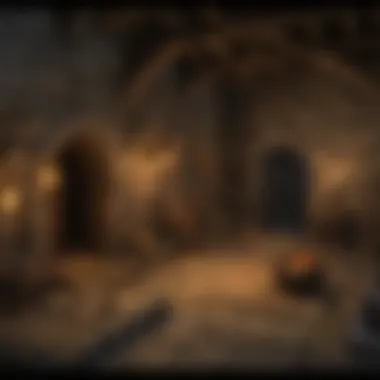
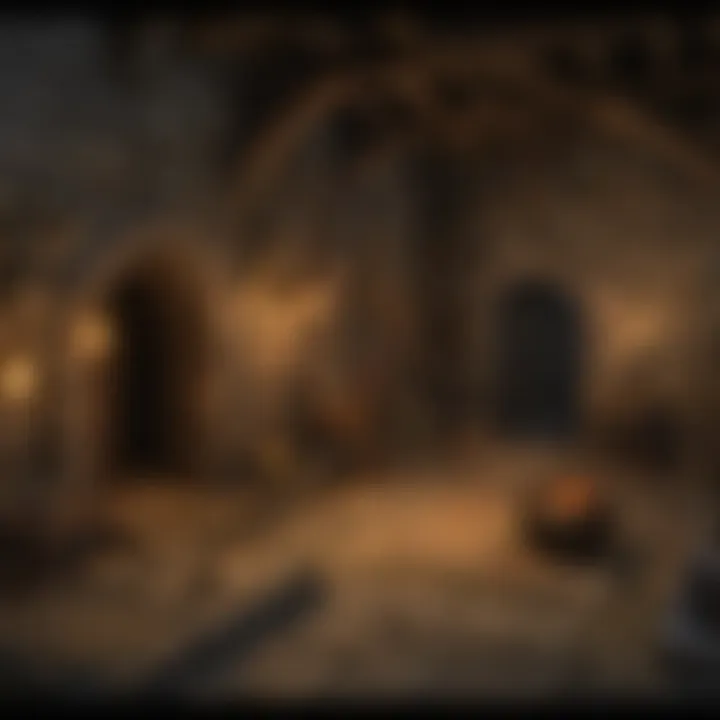
Benefits of integrating these aesthetics include:
- Increased Engagement: Players often feel a deeper connection when handling thematic pieces that echo their favorite games.
- Enhanced Memorability: Unique designs can make sessions more memorable. Players may more easily recall their adventures tied to specific dice.
- Boosted Creativity: Custom designs can inspire players to craft stories that incorporate the symbolic meanings linked to their dice.
Thus, visual flair becomes an essential component, ensuring that gameplay doesn’t feel monotonous, and drawing players deeper into the narrative.
Materials and Craftsmanship in Dice Production
Beneath the shiny surface of Zelda-themed dice lies a world of craftsmanship and material choice that significantly affects the gameplay. High-quality dice often utilize materials such as resin, metal, or even wood, depending on the aesthetic one is trying to achieve. Resin dice, adorned with glitter or colored swirls, can remind players of the magical essence of the Zelda universe. Conversely, metal dice provide a sturdier feel, introducing a tactile experience that might bring to mind the strength of legendary weapons like the Master Sword.
The craftsmanship can also vary widely. Customization opportunities allow players to seek out artisans who can create dice that mirror their personal experiences or suit specific campaign needs. Here are a few considerations when it comes to materials and craftsmanship:
- Durability: Some materials hold up better in physical play. Metal dice, for instance, can withstand the rigors of constant rolls, while resin is lighter and often more colorful.
- Balance: The weight distribution and form of dice can affect randomness, which is fundamental in RPGs. Poorly crafted dice can lead to skewed results, impacting overall fairness in gameplay.
- Sustainability: As more players become conscious about environmental impact, using sustainable materials for dice production is increasingly important.
Community and Culture: Zelda Dice Enthusiasts
The realm of Zelda dice enthusiasts serves as a vibrant microcosm of creativity and passion within the larger context of tabletop gaming. This community not only embraces the thematic allure of both The Legend of Zelda and Dungeons & Dragons, but it also cultivates an environment where shared interests foster camaraderie and innovation. By exploring this unique convergence, we can uncover the enriching experiences that arise from such collaboration.
Enthusiasts draw immense satisfaction from blending the intricate lore of Zelda with the imaginative storytelling aspects of D&D. The incorporation of themed dice—often decorated with symbols and colors reflective of Hyrule—creates not just a tool for gameplay, but a tangible connection to the beloved franchise. This sentimental value may encourage players to engage more deeply, drawing them in with the allure of nostalgia while also challenging them to forge new narratives.
Additionally, the community aspect provides players with a sense of belonging. At the core, these enthusiasts find solace in exploring alliances centered around shared experiences, whether this be through online forums or local game nights. In these spaces, there's a palpable exchange of tips, stories, and inspirations that go beyond simple game mechanics; this forms the backbone of community-building around these themed gaming elements.
Building a Community Around Themed Gaming
Creating a thriving community around Zelda-themed gaming requires intentional effort. Many enthusiasts organize local meetups, online discussions, and various gaming sessions that celebrate The Legend of Zelda and Dungeons & Dragons. These gatherings serve as a platform for players to not only showcase their dice collections but also to share their unique gameplay experiences and strategies. By blending the elements of social interaction and shared passion, these communities often yield richer gameplay experiences.
In addition to meetups, online spaces like Reddit and Facebook play pivotal roles in fostering connection. On platforms such as reddit.com, enthusiasts can ask questions, post artwork, and highlight their favorite gaming moments, thereby contributing to a growing repository of knowledge and creativity. Specific groups devoted to Zelda and D&D generate lively discussions and help new players navigate the complexities of gameplay. The Zelda Dungeon forum has even hosted threads dedicated to themed dice, offering insights and stories that spread enthusiasm like wildfire.
Benefits of Building Community
- Support System: Players can find guidance from seasoned gamers, making it easier to learn and adapt.
- Creative Exchange: Collaboration often leads to innovative ideas, both for gameplay and personalized dice designs.
- Emotional Connection: Sharing experiences and stories enhances the joy of gaming, making sessions more memorable.
In essence, the community aspect of Zelda dice enthusiasts is more than just an aggregation of fans; it's a catalyst for creativity and personal connections, making the D&D experience all the more enriching.
Events and Conventions Celebrating Zelda Dice
Events dedicated to both Zelda and Dungeons & Dragons embody the spirit of this unique intersection. Conventions provide a stage where enthusiasts can come together, share their love for themed gaming, and engage in activities that integrate the essence of both franchises. These gatherings often feature discussion panels, workshops, and open gaming opportunities that focus on how to blend Zelda lore with D&D gameplay, with the involved dice being key elements of play.
In some cases, conventions host tournaments explicitly designed for those utilizing Zelda-themed dice, giving attendees a platform to showcase their skills while also celebrating their shared interests. From the Zelda Universe Convention to Gen Con, such events have included various activities centered on thematic dice.
Moreover, these conventions often serve as breeding grounds for innovation. Players might experiment with new game mechanics that arise during collaborative sessions, thus influencing how both Zelda and D&D evolve within the gaming landscape. As dice change hands and ideas get tossed around, the lines between playstyle and creativity blur, inspiring fresh narratives that continue to resonate throughout the community.
Ultimately, events celebrating Zelda dice offer a convergence of fun, learning, and collaboration, solidifying communities while thriving on the lore and excitement that both franchises deliver.
Future of Zelda and & Collaborations
The topic of the future of Zelda and D&D collaborations is a fascinating one, reflecting the ongoing evolution of tabletop gaming as it intertwines with video game lore. This is especially true for fans who have grown up playing both Zelda titles and Dungeons & Dragons; there’s a unique blend of nostalgia and fresh discovery at this crossroads. As tabletop gameplay continues to expand, recognizing how these scenarios can evolve is crucial.
Incorporating themes from Zelda into D&D campaigns could introduce a variety of playful mechanics, vital for keeping players engaged. The future here can offer endless possibilities: new lore, character classes, and even quests that could pull directly from the rich tapestry of Zelda's universe.
Potential Innovations in Gaming Mechanics
One of the most exciting aspects of Zelda and D&D collaborations lies in the potential innovations in gaming mechanics. The idea of blending Zelda's puzzle-solving elements with the unpredictability of D&D's dice rolls could create a distinctive flavor in storytelling. Imagine a campaign where players must utilize a combination of strategic thinking and chance to retrieve artifacts akin to those found in Zelda; it would create a more dynamic interaction between players and game masters.
For instance, incorporating Zelda's famous Triforce into gameplay could encourage unique dice rolling mechanics. Each piece of the Triforce might correspond with different outcomes when rolled, allowing characters to gain special abilities or face additional challenges depending on their choices. Thus, the dice not only represent fate but also the intrinsic lore that players adore.
- New Abilities and Powers: Players might gain abilities directly attributed to Zelda characters like Link or Princess Zelda, adjusting their play style accordingly.
- Quest-Based Mechanics: Dice rolls could dictate quest challenges specific to familiar Zelda locations, thereby immersing players in a beloved world.
- Enhanced Cooperative Play: More emphasis on teamwork similar to how characters collaborate in both Zelda’s co-op modes and D&D’s party dynamics could enhance relationships among players.
"The confluence of two iconic worlds can foster creativity that transcends the individual elements they spring from."
Exploring New Narratives Inspired by Zelda
Exploring new narratives inspired by Zelda will also be pivotal as these two worlds continue to blend. The Zelda series is known for its epic tales of adventure, heroism, and the eternal struggle against darkness. Translating these narratives to D&D settings can breathe new life into both franchises.
Game masters can draw from Zelda lore to craft campaigns that spotlight similar themes of courage, wisdom, and power. For example, a campaign may be centered around the conflict between a dark entity trying to obtain the Triforce and the players, who assume the roles of heroes. Here, players can be empowered to weave Zelda-inspired backstories into their characters, further deepening their investment in the game.
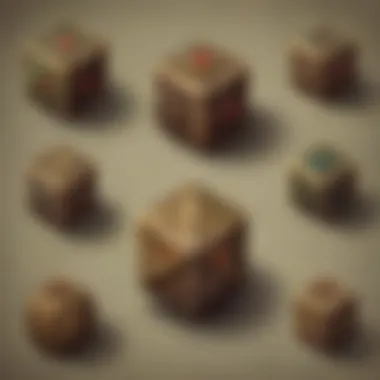
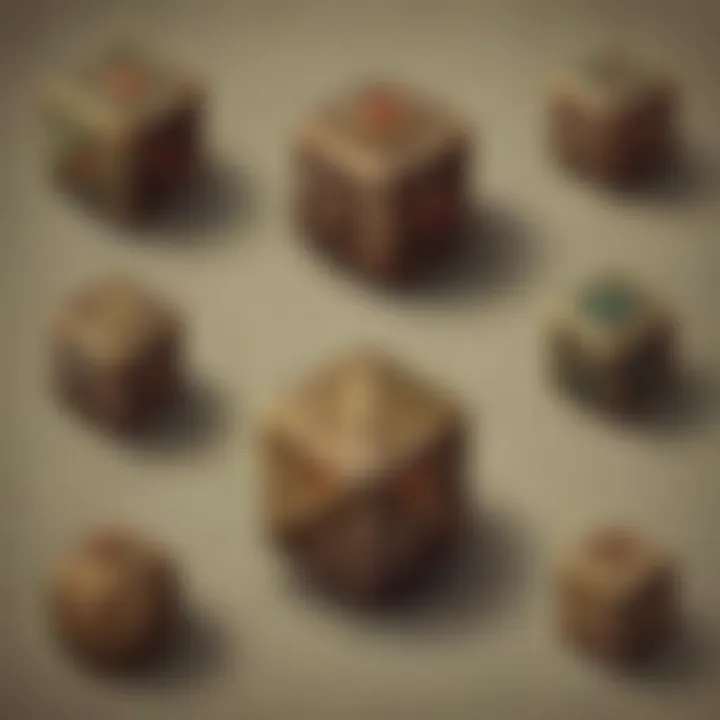
- Character Development: Each player might adopt a character's backstory influenced by Zelda, enhancing their motivations and emotions throughout the campaign.
- Moral Dilemmas: Introducing moral choices similar to those present in Zelda games can come into play, requiring players to choose between personal gain and the greater good.
- Interconnected Quests: Quest lines could draw parallels with the various trials and challenges found throughout the Zelda series, enticing players to explore this rich narrative landscape.
As we look to the future, these collaborations hold the promise of more than just games; they could evolve into immersive experiences that resonate with an audience that values both creativity and community, bridging the gap between the worlds of tabletop gaming and video game storytelling.
Educational Aspects of Themed Dice in Gaming
The thematic elements of dice in tabletop games like Dungeons & Dragons, especially those inspired by Zelda, go beyond mere aesthetics. They serve as tools that enhance the ludic experience while contributing to educational outcomes. By integrating storytelling and gameplay, themed dice offer players not just entertainment but also a rich platform for learning crucial skills.
Enhancing Problem-Solving Skills Through RPGs
When you roll a die, a simple act transpires; however, in the depths of a role-playing game, each roll is a step into a larger narrative. The whimsical designs of Zelda dice, adorned with symbols from the series, create an engaging context that fosters problem-solving. Players must strategize based on the results of dice rolls, weighing their options and considering potential consequences.
- Players might face a scenario where they need to negotiate safe passage through a monster-infested forest. Will they persuade the creature with evidence from past interactions or fight it outright?
- Each choice leads to different outcomes, reinforcing critical thinking and decision-making skills as players analyze risks versus rewards.
As encounters become more intricate, the necessity to devise innovative solutions grows. This encourages teamwork as players collaborate to overcome challenges, setting the stage for the development of social and cognitive skills.
Fostering Creativity and Storytelling Techniques
The unique charm of themed dice brings forth a canvas for creativity and imaginative storytelling. When players select a beautifully crafted die featuring the Triforce or Heart Containers, it instills a sense of personal connection to the game. This connection encourages players to weave their narratives, expanding on the game's lore with their flair.
- By embedding Zelda lore, players can create backstories for their characters that align with themes of heroism, courage, and adventure.
- Moreover, rolling a die that represents a beloved game element prompts spontaneous storytelling, where the outcome of the roll may guide unexpected plot twists or character developments.
The thematic element of dice thus transforms a routine mechanics into a storytelling tool that enhances engagement. The act of rolling dice becomes a catalyst for creativity, pushing players to think outside the box.
"RPGs, particularly those infused with rich lore, empower players to test their creativity and adaptability, making each session an evolving story."
In summary, themed dice are more than just decorative pieces in D&D campaigns. They are instrumental in shaping educational aspects of gameplay while helping players develop problem-solving abilities and storytelling skills. Embracing these elements cultivates an enriching experience, allowing the confluence of Zelda lore and narrative-driven RPGs to flourish in fascinating and educational ways.
Challenges and Criticisms of Themed Dice
The charm and artistry of themed dice, especially those inspired by the rich lore of Zelda, often masks the challenges and criticisms tied to their use in tabletop gaming like Dungeons & Dragons. While they undoubtedly enhance the gaming experience through unique designs and aesthetic appeal, one must also consider the underlying complexities that arise when integrating such novelties into gameplay. Addressing these challenges not only helps in understanding the broader significance of themed dice but also aids gamers in navigating the intricacies of their use.
Balancing Aesthetics with Functionality
One prominent concern involves finding the right balance between aesthetic appeal and functionality. Themed dice can certainly be beautiful, featuring intricate designs that evoke imagery from the Zelda universe, like the Triforce symbol or Hyrule's various landscapes. However, the practicality of these dice can sometimes be compromised. Gamers may find that while these pieces look splendid on the gaming table, they might not roll as well or have the same weight and feel as more traditional gaming dice.
For instance, a die shaped like a rupee might catch the eye, but if its balance is off, it could lead to uneven outcomes during gameplay. This raises a question many players face:
- Is it worth using visually captivating dice that might disrupt the game experience?
- How can players assess whether a beautiful die will perform well?
Instead of sacrificing function for fashion, players should consider testing dice before committing to them in important gaming sessions. This practice ensures that both the aesthetics and functionality work in harmony, allowing for an enriching role-playing experience.
Navigating Commercialization in Hobby Gaming
Another significant challenge lies in the commercialization of themed gaming accessories. As the demand for Zelda-based dice has surged, numerous companies have jumped into the market, offering an array of products. While this wide availability is generally positive, it sometimes leads to concerns about the quality of the dice being produced. Some manufacturers might prioritize profit over the experience they deliver through their products.
Moreover, the commercialization can detract from what tabletop gaming is all about: camaraderie and creativity. When focus shifts towards acquiring the latest themed dice simply because they are 'in vogue', some enthusiasts might overlook the deeper narratives or connections that make games like Dungeons & Dragons a shared experience. The hobby risks becoming more about collecting than playing, leading to potential divisions among players who may feel compelled to keep up with trends merely for status.
- Hence, it is crucial to approach themed dice not just as collectibles but as tools for storytelling and engagement.
- Players should strive to choose dice that reflect their personal connection with the game rather than being swayed solely by marketing trends.
Finale and Reflections
In wrapping up this exploration of Zelda lore and the intricate tapestry of Dungeons & Dragons, it becomes evident that the interplay between these two iconic worlds offers rich insights into not only gameplay but also community dynamics. The significance of themed dice stands tall, symbolizing a bridge that connects players to the essence of both franchises. These dice serve as more than just randomizers; they are artifacts that encapsulate the spirit and adventure of the Zelda universe, making each roll resonate with layers of nostalgia and creativity.
This final section seeks to clarify the multiple layers that tie together the influence of Zelda’s narrative aesthetics and the mechanics inherent in D&D. For enthusiasts, the avenues offered by themed dice extend beyond simple aesthetics. They enhance immersion into the lore, prompting broader reflections on how settings, character arcs, and plot developments unfold during gameplay. In an age where community interconnectedness thrives, the communal aspect of using themed dice fosters a deeper engagement among players sharing similar passions.
Summarizing Key Insights on Zelda Dice
The journey through this article sheds light on key takeaways regarding Zelda-themed dice. These insights encapsulate not just the enjoyment found in their use, but also the purpose they serve within both casual and serious gaming environments:
- Immersion: The unique designs of Zelda-themed dice allow players to feel more integrated into the universe, transforming mundane probability into something magical.
- Storytelling Enhancement: The visual cues from the dice can inspire spontaneous narratives or quests that tie back into beloved Zelda tales.
- Community Building: Shared interests in Zelda-themed gaming products cultivate bonds through events, discussions, and collaborative campaigns, strengthening the overall gaming experience.
"The alignment of dice and lore brings players closer to the world of Hyrule, stimulating skills they didn't know they possessed."
The Future Path for Themed Role-Playing Games
Looking ahead, the trajectory of themed role-playing games—especially those merging beloved universes like Zelda and D&D—hints at numerous exciting developments. The integration of technology will likely play a key role:
- Digital Gameplay Integration: With the rise of online platforms, themed dice may find their place in virtual settings, where interactive installations mimic the familiar feel of tabletop gaming.
- Expanded Collaborative Projects: As gaming companies recognize the cross-pollination potential, we may see more initiatives that combine narrative elements of various franchises, leading to enriched gaming mechanics and diverse play environments.
- Community Driven Innovations: Engaged gamers are often the ones to push boundaries. Collaborations focused on community needs and feedback will drive the future of themed gaming, potentially resulting in customizable dice sets that cater specifically to player preferences.
Through these prospects, the fusion of Zelda lore and Dungeons & Dragons tells a story of continual evolution, where creativity knows no bounds. Embracing the exciting combination of storytelling, mechanics, and community formation presents a thrilling endeavor—for present and future gamers alike.







